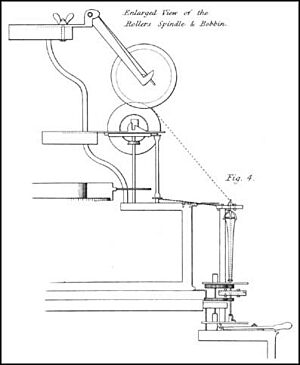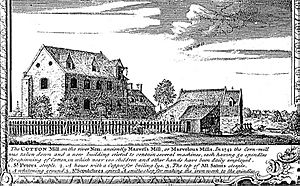Paul-Wyatt cotton mills facts for kids
The Paul-Wyatt cotton mills were the world's first factories that used machines to spin cotton. They ran from 1741 to 1764. These mills were built to use the special roller spinning machines. These machines were invented by Lewis Paul and John Wyatt. Even though they didn't make a lot of money, they successfully spun cotton for many years.
Contents
How the Mills Started
In 1738, Lewis Paul and John Wyatt received a special permit called a patent. This patent was for their new cotton spinning machine. For the first time, this machine used two sets of rollers. These rollers moved at different speeds. This allowed cotton to be spun completely by machine.
The New Spinning Idea
Their patent described two important ideas. These ideas were later used in other famous inventions. These included Richard Arkwright's water frame and James Hargreaves' spinning jenny. Paul and Wyatt's invention made it possible for one power source to run many spinning machines. Wyatt imagined a "kind of mill" that could be powered by horses, water, or wind.
First Cotton Mill in Birmingham
Using this new technology, Paul and Wyatt opened a mill in Birmingham. This happened in the summer of 1741. It was called the Upper Priory Cotton Mill. This was the first mill to spin cotton "without the aid of human fingers." This means machines did the work, not people's hands.
The mill had fifty rollers. Two donkeys walked around to power them. However, this mill was not very successful. Wyatt found it hard to organize the workers and the large operation. He was good at inventing, but not at managing a big business.
Challenges and Other Mills
Two years after it opened, the mill was in a "pitiful state." Wyatt faced financial problems. He could not continue working on the mill for a time. Later, Matthew Boulton said the mill "would have got money had it been in good hands." We don't know what happened to this mill after 1743.
Four more mills were built using Paul-Wyatt machines. This happened in the years that followed. Edward Cave, a publisher, tried running the machines by hand in London. By 1742, he had set up 250 spindles at Marvell's Mill in Northampton. This mill was powered by water. It was the first cotton mill to use water power.
Cave also had trouble managing his workers. He wrote that he didn't have enough people coming to work. The mill did not make much money. But it kept running until about 1764.
More Mills and New Ideas
Samuel Touchet opened a second mill in Birmingham with Paul and Wyatt in 1744. We don't know much about this mill. But it must have been promising. Touchet later rented the Northampton mill from Cave until 1755.
The last mill was Pinsley Mill in Leominster. It was started by Daniel Bourn. It might have been running by 1744. It was first mentioned in 1748. At that time, both Bourn and Paul patented machines for carding cotton. Carding is a step before spinning. It prepares the cotton fibers.
Bourn's mill burned down in 1754. But it was very famous. A newspaper called the Manchester Mercury said it was built with "great expense and skill." It was "viewed with great pleasure and admiration by travellers."



